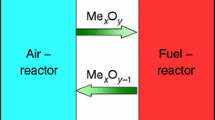Abstract
Chemical looping combustion (CLC) is a novel combustion technology with the capability for segregation of exhaust products (i.e., carbon dioxide/H2O or N2/O2). The combustion is performed in two interconnected reactors with a solid oxygen carrier circulating between them, transferring oxygen from the air to the fuel. The feasibility of a successful CLC system depends on the selection of an appropriate oxygen carrier. Cu-based oxygen carriers are good oxygen carriers due to high reactivity. However, it faces low melting point, agglomeration problems in fluidized bed. In this study, a circular reduction–oxidation reaction simulated to the cyclic operation of the Cu-based oxygen carrier was conducted on the thermogravimetric analyzer (TG). The thermal behaviors of the potential Cu-based oxygen carrier were investigated by using an X-ray diffraction (XRD), scanning electron microscope (SEM), and surface analyzer. Multiple TG results show that the weight loss was 3.4%, indicating that the loading CuO amount was 17%. Moreover, the weight loss and weight gain was equal during 73 redox cycles, suggesting the good thermal stability of the oxygen carrier. The conversion rate of reduction and oxidation for each redox cycle remained constant even after 73 redox cycles. XRD results show the new phase formation of CuAl2O4 during redox cycles, which promotes the thermal stabilization of the oxygen carrier. The surface area of the oxygen carrier decreased from 105 to 13 m2 g−1 after 73 redox cycles and the particle size distribution shifted from 5–15 nm to 15–30 nm, suggesting that the micorpores were blocked or collapsed. However, the reactivity of the oxygen carrier didn’t decrease. SEM results show that CuO was evenly distributed on the surface of Al2O3 after 73 redox cycles. Overall, these results suggested that the Cu-based oxygen carrier was ready for fluidized bed tests.






Similar content being viewed by others
References
Mattisson T, Adanez J, Proell T, Kuusik R, Beal C, Assink J, Snijkers F, Lyngfelt A. Chemical-looping combustion CO2 ready gas power. Energy Procedia. 2009;1:1557–64.
De Diego L, Garcia-Labiano F, Adanez J, Gayan P, Abad A, Corbella B, Palacios JM. Development of Cu-based oxygen carriers for chemical-looping combustion. Fuel. 2004;83:1749–57.
Siriwardane R, Tian HJ, Richard G, Simonyi T, Poston J. Chemical-looping combustion of coal with metal oxide oxygen carriers. Energy Fuels. 2009;23:3885–92.
Cho P, Mattisson T, Lyngfelt A. Comparison of iron-, nickel, copper- and manganese-based oxygen carriers for chemical-looping combustion. Fuel. 2004;83:1215–25.
Jerndal E, Mattisson T, Lyngfelt A. Investigation of different NiO/NiAl2O4 particles as oxygen carriers for chemical-looping combustion. Energy Fuels. 2009;23:665–76.
Wolf J, Anheden M, Yan JY. Comparison of nickel- and iron-based oxygen carriers in chemical looping combustion for CO2 capture in power generation. Fuel. 2005;84:993–1006.
Cao Y, Pan WP. Investigation of chemical looping combustion by solid fuels. 1. Process analysis. Energy Fuels. 2006;20:1836–44.
Tian HJ, Chaudhari K, Simonyi T, Poston J, Liu TF, Sanders T, Veser G, Siriwardane R. Chemical-looping combustion of coal derived synthesis gas over copper oxide oxygen carriers. Energy Fuels. 2008;22:3744–55.
Garcia-Labiano F, Diego LF, Adanez J, Abad A, Gayan P. Chem. Effect of pressure on the behavior of copper-, iron-, and nickel-based oxygen carriers for chemical-looping combustion. Eng Sci. 2005;60:851–62.
Moran-Pineda M, Castillo S, Asomoza M, Gomez R. Copper oxide on Cu/Al2O3-TiO2 catalysts TG, FTIR-CO absorption and catalytic activity in the NO reduction by CO. J Therm Anal Cal. 2003;73:341–6.
Jin HG, Ishida M. A new type of coal gas fueled chemical-looping combustion. Fuel. 2004;83:2011–7.
Jin HG, Okamoto T, Ishida M. Development of a novel chemical-looping combustion: synthesis of looping material with a double metal oxide of CoO-NiO. Energy Fuels. 1998;12(6):1272–7.
Ishida M, Jin HG. A novel chemical-looping combustor without NO x formation. Ind Eng Chem Res. 1996;35:2469–72.
Degif LF, Gayan P, Garcia-labiano F, Celaya J, Abad A, Adanez J. Impregnated CuO/Al2O3 oxygen carriers for chemical-looping combustion: avoiding fluidized bed agglomeration. Energy Fuels. 2005;19:1850–6.
Zafar Q, Abad A, Mattisson T, Gever B. Reaction kinetics of freeze-granulated NiO/MgAl2O4 oxygen carrier particles for chemical-looping combustion. Energy Fuels. 2007;21:610–8.
Zhao HB, Liu LM, Xu D, Zheng CG, Liu GJ, Jiang LL. NiO/NiAl2O4 oxygen carriers prepared by sol-gel for chemical-looping combustion fueled by gas. J Fuel Chem Tech. 2008;36:261–6.
Acknowledgements
We gratefully acknowledge financial supports through projects by the United State Department of Energy (DE-FC26-FE0001808).
Author information
Authors and Affiliations
Corresponding author
Rights and permissions
About this article
Cite this article
Zhao, Hy., Cao, Y., Kang, Zz. et al. Thermal characteristics of Cu-based oxygen carriers. J Therm Anal Calorim 109, 1105–1109 (2012). https://doi.org/10.1007/s10973-011-2001-z
Published:
Issue Date:
DOI: https://doi.org/10.1007/s10973-011-2001-z




